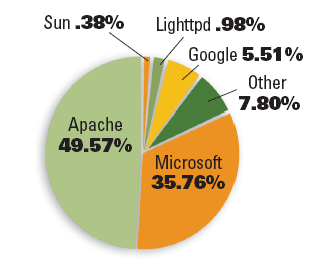SEO-Friendly Hosting

by Peter Devereaux
31 Jan, 2008
By Lloyd Brown
__________________________________________
It's no secret that Google modifies their algorithm in what seems to be an effort to fight attempts to "beat the system." Several years ago Google announced the implementation of their Automatic Filtering. When enabled, one of the effects takes the form of a host crowding penalty - if multiple results come from the same Web host, only the first two are returned.
One suggested solution is to simply disable the filter. But the odds of users doing this, or even knowing how to disable the filter are slim. Therefore, the filter remains active and users are not seeing what are considered duplicate results because of the host crowding penalty. As a result, many companies, whose only sin was having multiple sites all on the same host, lost significant traffic from search engines.
Another solution is to host your websites with multiple hosts. But this forces you to manage multiple control panels, bills and contacts.
If you manage several websites, you may want to consider a better solution - niche Web hosts that provide IP ranges spread out over multiple Class A or C subnets, giving search engines the impression that your sites reside across different hosts. This is important when you have sites that promote similar products, or when you want to interlink the sites you have into your own mini-network - another reason for Google to impose the penalty. Plus, you get the added convenience of one bill, one contact and usually one control panel to manage all of your sites.
Choosing a C-Class Host
Choosing a proper host can be difficult. Many know that website owners are seeking SEO-friendly hosting, but do not understand why. As a result, many providers sell hosting plans with multiple Class Cs, but they share IPs with multiple customers - mainly because by not sharing IPs, hosts are limited as to how many customers they can serve. But this can be dangerous for a website owner. If you share an IP with an unseemly website owner you run the risk of having the entire IP banned, instantly losing your search credibility. And some hosts will put upwards of 9,000 different domains on one IP. Like many things, you often get what you pay for.
Bruce Clay observed that although only 3 percent of websites are on dedicated IPs, well over 90 percent of the top-50 results in the search engines are sites having dedicated IP numbers. They confirmed this by moving a site from a shared IP to a dedicated IP and noticed "significant ranking increases."
Websites live and die with their search rankings. So it's important to optimize your portfolio of sites, including spreading out your domains through a dedicated, C-Class hosting service. As an added bonus, spreading out your sites over multiple IPs makes it difficult for your competitors to find all of your sites through a simple reverse IP lookup.
__________________________________________
It's no secret that Google modifies their algorithm in what seems to be an effort to fight attempts to "beat the system." Several years ago Google announced the implementation of their Automatic Filtering. When enabled, one of the effects takes the form of a host crowding penalty - if multiple results come from the same Web host, only the first two are returned.
One suggested solution is to simply disable the filter. But the odds of users doing this, or even knowing how to disable the filter are slim. Therefore, the filter remains active and users are not seeing what are considered duplicate results because of the host crowding penalty. As a result, many companies, whose only sin was having multiple sites all on the same host, lost significant traffic from search engines.
Another solution is to host your websites with multiple hosts. But this forces you to manage multiple control panels, bills and contacts.
If you manage several websites, you may want to consider a better solution - niche Web hosts that provide IP ranges spread out over multiple Class A or C subnets, giving search engines the impression that your sites reside across different hosts. This is important when you have sites that promote similar products, or when you want to interlink the sites you have into your own mini-network - another reason for Google to impose the penalty. Plus, you get the added convenience of one bill, one contact and usually one control panel to manage all of your sites.
Choosing a C-Class Host
Choosing a proper host can be difficult. Many know that website owners are seeking SEO-friendly hosting, but do not understand why. As a result, many providers sell hosting plans with multiple Class Cs, but they share IPs with multiple customers - mainly because by not sharing IPs, hosts are limited as to how many customers they can serve. But this can be dangerous for a website owner. If you share an IP with an unseemly website owner you run the risk of having the entire IP banned, instantly losing your search credibility. And some hosts will put upwards of 9,000 different domains on one IP. Like many things, you often get what you pay for.
Bruce Clay observed that although only 3 percent of websites are on dedicated IPs, well over 90 percent of the top-50 results in the search engines are sites having dedicated IP numbers. They confirmed this by moving a site from a shared IP to a dedicated IP and noticed "significant ranking increases."
Websites live and die with their search rankings. So it's important to optimize your portfolio of sites, including spreading out your domains through a dedicated, C-Class hosting service. As an added bonus, spreading out your sites over multiple IPs makes it difficult for your competitors to find all of your sites through a simple reverse IP lookup.
| |
The Web's growth continues virtually unabated. Netcraft's 2007 Web Server Survey found the Web growing by nearly 50 million sites since December 2006 (19 million new, active sites for annual growth of 38%). While there continues to be strong growth in traditional hosting, Netcraft reports the most dramatic growth were sites at blogging services providers such as MySpace, Live Spaces and Blogger - accounting for approximately 25 million of the more than 155 million sites of which Netcraft received responses. So what servers are these sites running on? |

About the Author: Lloyd Brown is Director of Business Development for Got Web Host - a premier provider of Class C hosting and leader in SEO hosting services. Brown's portfolio includes nearly 10 years of Internet marketing experience.

Peter Devereaux
As the Editor-in-Chief of Website Magazine and President of Website Services, Peter has established himself as a prominent figure in the digital marketing industry. With a wealth of experience and knowledge, Peter has been a driving force in shaping the landscape of digital marketing. His leadership in creating innovative and targeted marketing campaigns has helped numerous businesses achieve their revenue growth goals. Under his direction, Website Magazine has become a trusted source of information and insights for digital marketers worldwide. As President of Website Services, Peter oversees a team of talented professionals who specialize in SEO/SEM, email marketing, social media, and digital advertising. Through his hands-on approach, he ensures that his team delivers exceptional results to their clients. With a passion for digital marketing, Peter is committed to staying up-to-date with the latest industry trends and technologies, making him a sought-after thought leader in the field.








